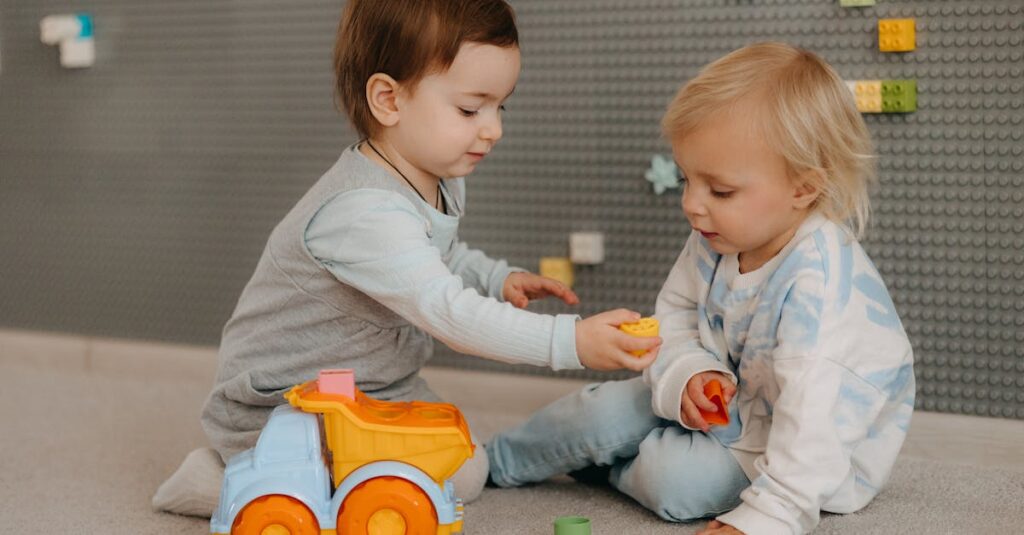The Importance of Teaching Generosity Early
Kids absorb behaviors like little sponges. That’s why introducing generosity at a young age is crucial. When children learn to share, they develop empathy and a sense of community. Think of it as planting seeds for future kindness.
Watching your child offer a toy or split a cookie might be small gestures, but they make a world of difference. It’s like baby steps in building a peaceful world. Plus, teaching sharing helps them build friendships.
At preschool age, kids are naturally curious and open to learning, so you’re primed to teach these valuable life skills. Pro tip: be their role model. Share your favorite dessert with them – you might get a bite if you’re lucky!
Practical Ways to Share Toys and Time
Sharing doesn’t come naturally to most kids. It’s kind of like asking you to share the last slice of pizza! But with gentle reminders and fun interactions, preschoolers can learn to share toys and time.
Start with Setting Boundaries
Explain when it’s appropriate to share. Let them take the lead.
- If your child is into cars, suggest they share their toy Ferrari.
- Tell them sharing is like giving your friend a guest pass into your awesome world.
Practical? Yes. Magical? Absolutely.
You’ll see fewer squabbles over the Legos and more fun times with balanced sharing.
Navigating Emotional Hurdles
Tantrums galore when sharing is on the agenda? You’re not alone. Many parents face the emotional whirlwind when teaching preschoolers to share. It’s a bit like trying to negotiate a peace treaty over a stuffed animal.
Start by acknowledging their feelings. “I see you really want to play with your stuffed lion right now.” Validation is key. Then, shift their focus to how it makes others feel. “Sharing it might make your friend really happy.”
Kids sometimes act like tiny emotional tornadoes, and that’s okay. Patience and understanding will weather any sharing storm.
Games and Activities to Encourage Sharing
Turn sharing into a fun game! Organize playdates where sharing is part of the activities. Try building a ‘sharing circle’ where kids sit in a circle and pass toys around. Think of it as musical chairs, but with sharing.
Encouraging teamwork is crucial, and integrating games makes the process enjoyable. Watch as your child goes from ‘mine, mine, mine’ to ‘yours, mine, and ours.’
Chuckle together when their beloved teddy plays a guest role in someone else’s imagination. After all, fostering generosity shouldn’t feel like a chore but rather an adventure!
Storytelling as a Tool for Generosity
Captivate your child’s imagination by weaving tales about generosity. Storytelling can nurture generosity like nothing else. Include characters that display sharing behavior. For example, Charlie the Chatty Rabbit who loves to share his carrot stash with friends!
Dive into stories together and explore the what-ifs. Ask questions such as:
- What if Charlie didn’t share his carrots?
This encourages empathy and understanding. Plus, who doesn’t love a good story time snuggle? Use this moment to bond with your child and simultaneously teach them about the joy of generosity.
Inviting Interactive Family Participation
Parents, let’s not forget that you play a big role here too. Make generosity a family affair! Host ‘family sharing days’ where everyone takes turns sharing something they love or appreciate. It doesn’t have to be extravagant.
Sharing could mean:
- Lending a helping hand with household chores
- Setting aside some family time technology-free
Encourage your child to share their day’s highlights with the family. This opens up pathways for conversation and learning. After all, generosity is not just about giving toys; it’s also about giving time and attention.
Ready to embark on this generosity journey with your little ones? Let’s get started!

